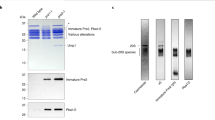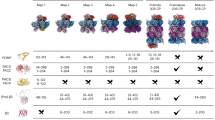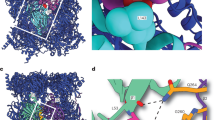Abstract
Eukaryotic 20S proteasomes are composed of two α-rings and two β-rings, which form an αββα stacked structure. Here we describe a proteasome-specific chaperone complex, designated Dmp1–Dmp2, in budding yeast. Dmp1–Dmp2 directly bound to the α5 subunit to facilitate α-ring formation. In Δdmp1 cells, α-rings lacking α4 and decreased formation of 20S proteasomes were observed. Dmp1–Dmp2 interacted with proteasome precursors early during proteasome assembly and dissociated from the precursors before the formation of half-proteasomes. Notably, the crystallographic structures of Dmp1 and Dmp2 closely resemble that of PAC3—a mammalian proteasome-assembling chaperone; nonetheless, neither Dmp1 nor Dmp2 showed obvious sequence similarity to PAC3. The structure of the Dmp1–Dmp2–α5 complex reveals how this chaperone functions in proteasome assembly and why it dissociates from proteasome precursors before the β-rings are assembled.
This is a preview of subscription content, access via your institution
Access options
Subscribe to this journal
Receive 12 print issues and online access
$189.00 per year
only $15.75 per issue
Buy this article
- Purchase on Springer Link
- Instant access to full article PDF
Prices may be subject to local taxes which are calculated during checkout







Similar content being viewed by others
References
Baumeister, W., Walz, J., Zuhl, F. & Seemuller, E. The proteasome: paradigm of a self-compartmentalizing protease. Cell 92, 367–380 (1998).
Coux, O., Tanaka, K. & Goldberg, A.L. Structure and functions of the 20S and 26S proteasomes. Annu. Rev. Biochem. 65, 801–847 (1996).
Zwickl, P., Kleinz, J. & Baumeister, W. Critical elements in proteasome assembly. Nat. Struct. Biol. 1, 765–770 (1994).
Chen, P. & Hochstrasser, M. Biogenesis, structure and function of the yeast 20S proteasome. EMBO J. 14, 2620–2630 (1995).
Hirano, Y. et al. A heterodimeric complex that promotes the assembly of mammalian 20S proteasomes. Nature 437, 1381–1385 (2005).
Nandi, D., Woodward, E., Ginsburg, D.B. & Monaco, J.J. Intermediates in the formation of mouse 20S proteasomes: implications for the assembly of precursor β subunits. EMBO J. 16, 5363–5375 (1997).
Li, X., Kusmierczyk, A.R., Wong, P., Emili, A. & Hochstrasser, M. β-Subunit appendages promote 20S proteasome assembly by overcoming an Ump1-dependent checkpoint. EMBO J. 26, 2339–2349 (2007).
Ramos, P.C., Hockendorff, J., Johnson, E.S., Varshavsky, A. & Dohmen, R.J. Ump1p is required for proper maturation of the 20S proteasome and becomes its substrate upon completion of the assembly. Cell 92, 489–499 (1998).
Hirano, Y. et al. Cooperation of multiple chaperones required for the assembly of mammalian 20S proteasomes. Mol. Cell 24, 977–984 (2006).
Burri, L. et al. Identification and characterization of a mammalian protein interacting with 20S proteasome precursors. Proc. Natl. Acad. Sci. USA 97, 10348–10353 (2000).
Heink, S., Ludwig, D., Kloetzel, P.M. & Kruger, E. IFN-γ-induced immune adaptation of the proteasome system is an accelerated and transient response. Proc. Natl. Acad. Sci. USA 102, 9241–9246 (2005).
Jayarapu, K. & Griffin, T.A. Protein-protein interactions among human 20S proteasome subunits and proteassemblin. Biochem. Biophys. Res. Commun. 314, 523–528 (2004).
Bachmair, A., Finley, D. & Varshavsky, A. In vivo half-life of a protein is a function of its amino-terminal residue. Science 234, 179–186 (1986).
Johnson, E.S., Ma, P.C., Ota, I.M. & Varshavsky, A. A proteolytic pathway that recognizes ubiquitin as a degradation signal. J. Biol. Chem. 270, 17442–17456 (1995).
Meimoun, A. et al. Degradation of the transcription factor Gcn4 requires the kinase Pho85 and the SCF(CDC4) ubiquitin-ligase complex. Mol. Biol. Cell 11, 915–927 (2000).
Mannhaupt, G., Schnall, R., Karpov, V., Vetter, I. & Feldmann, H. Rpn4p acts as a transcription factor by binding to PACE, a nonamer box found upstream of 26S proteasomal and other genes in yeast. FEBS Lett. 450, 27–34 (1999).
Xie, Y. & Varshavsky, A. RPN4 is a ligand, substrate, and transcriptional regulator of the 26S proteasome: a negative feedback circuit. Proc. Natl. Acad. Sci. USA 98, 3056–3061 (2001).
Glickman, M.H. et al. Functional analysis of the proteasome regulatory particle. Mol. Biol. Rep. 26, 21–28 (1999).
Fehlker, M., Wendler, P., Lehmann, A. & Enenkel, C. Blm3 is part of nascent proteasomes and is involved in a late stage of nuclear proteasome assembly. EMBO Rep. 4, 959–963 (2003).
Schmidt, M. et al. The HEAT repeat protein Blm10 regulates the yeast proteasome by capping the core particle. Nat. Struct. Mol. Biol. 12, 294–303 (2005).
Groll, M. et al. Structure of 20S proteasome from yeast at 2.4 Å resolution. Nature 386, 463–471 (1997).
Unno, M. et al. The structure of the mammalian 20S proteasome at 2.75 Å resolution. Structure 10, 609–618 (2002).
Tallec, B. et al. 20S Proteasome assembly is orchestrated by two distinct pairs of chaperones in yeast and in mammals. Mol. Cell 27, 660–674 (2007).
Tanaka, K. et al. Proteasomes (multi-protease complexes) as 20 S ring-shaped particles in a variety of eukaryotic cells. J. Biol. Chem. 263, 16209–16217 (1988).
Takeuchi, J., Fujimuro, M., Yokosawa, H., Tanaka, K. & Toh-e, A. Rpn9 is required for efficient assembly of the yeast 26S proteasome. Mol. Cell. Biol. 19, 6575–6584 (1999).
Otwinowski, Z. & Minor, W. Processing of x-ray diffraction data collected in oscillation mode. Methods Enzymol. 276, 307–326 (1997).
Schneider, T.R. & Sheldrick, G.M. Substructure solution with SHELXD. Acta Crystallogr. D Biol. Crystallogr. 58, 1772–1779 (2002).
Bricogne, G., Vonrhein, C., Flensburg, C., Schiltz, M. & Paciorek, W. Generation, representation and flow of phase information in structure determination: recent developments in and around SHARP 2.0. Acta Crystallogr. D Biol. Crystallogr. 59, 2023–2030 (2003).
CCP4. The CCP4 suite: programs for protein crystallography. Acta Crystallogr. D Biol. Crystallogr. 50, 760–763 (1994).
Vagin, A.A. & Teplyakov, A. MOLREP: an automated Program for molecular replacement. J. Appl. Crystallogr. 30, 1022–1025 (1997).
Morris, R.J., Perrakis, A, & Lamzin, V.S. ARP/wARP and automatic interpretation of protein electron density maps. Methods Enzymol. 374, 229–244 (2003).
Emsley, P. & Cowtan, K. Coot: model-building tools for molecular graphics. Acta Crystallogr. D Biol. Crystallogr. 60, 2126–2132 (2004).
Murshudov, G.N., Vagin, A.A. & Dodson, E.J. Refinement of macromolecular structures by the maximum-likelihood method. Acta Crystallogr. D Biol. Crystallogr. 53, 240–255 (1997).
Kraulis, P.J. MOLSCRIPT: a program to produce both detailed and schematic plots of protein structures. J. Appl. Crystallogr. 24, 946–950 (1991).
Merritt, E.A. & Murphy, M.E. Raster3D Version 2.0. A program for photorealistic molecular graphics. Acta Crystallogr. D Biol. Crystallogr. 50, 869–873 (1994).
Potterton, E., McNicholas, S., Krissinel, E., Cowtan, K. & Noble, M. The CCP4 molecular-graphics project. Acta Crystallogr. D Biol. Crystallogr. 58, 1955–1957 (2002).
Acknowledgements
We thank all of the members of BL44XU, especially E. Yamashita and M. Yoshimura, for their help in data collection at SPring-8 and T. Hikage for his help in X-ray diffraction data collection for PAC3. This work was supported by grants from Japan Science and Technology Agency (to S.M.), the Ministry of Education, Culture, Sports, Science and Technology (MEXT) of Japan (to H.Y., T.M., S.M., E.K., K.K. and K. Tanaka) and the Target Protein Project of MEXT (to T.M., K.K. and K. Tanaka and the Takeda Science Foundation (to K. Tanaka)). E.S. is a recipient of a Japan Society for the Promotion of Science Research Fellowship for Young Scientists.
Author information
Authors and Affiliations
Contributions
H.Y. and T. Kameyama performed all of the yeast experiments. T.M., H.Y., K. Takagi and T.Y. determined the structures of the Dmp1–Dmp2 and Dmp1–Dmp2 Δloop-α5 complexes. K.O., E.K., E.S., A.S., Y.H., S.M., T.Y. and K.K. determined the structure of PAC3. H.H., T. Kishimoto and S.N. conducted the mass spectrometric analysis. M.K. performed phylogenetic analyses. H.Y., T.M., K.K., M.K. and K. Tanaka wrote the paper. All of the authors discussed the results and commented on the manuscript.
Corresponding author
Supplementary information
Supplementary Text and Figures
Supplementary Figures 1–6, Tables 1 and 2 and Methods (PDF 1364 kb)
Rights and permissions
About this article
Cite this article
Yashiroda, H., Mizushima, T., Okamoto, K. et al. Crystal structure of a chaperone complex that contributes to the assembly of yeast 20S proteasomes. Nat Struct Mol Biol 15, 228–236 (2008). https://doi.org/10.1038/nsmb.1386
Received:
Accepted:
Published:
Issue Date:
DOI: https://doi.org/10.1038/nsmb.1386
This article is cited by
-
How to build a proteasome
Nature Structural & Molecular Biology (2021)
-
Proteasome subunit α1 overexpression preferentially drives canonical proteasome biogenesis and enhances stress tolerance in yeast
Scientific Reports (2019)
-
Structural insights on the dynamics of proteasome formation
Biophysical Reviews (2018)
-
Two-step process for disassembly mechanism of proteasome α7 homo-tetradecamer by α6 revealed by high-speed atomic force microscopy
Scientific Reports (2017)
-
Alpha-ring Independent Assembly of the 20S Proteasome
Scientific Reports (2015)



